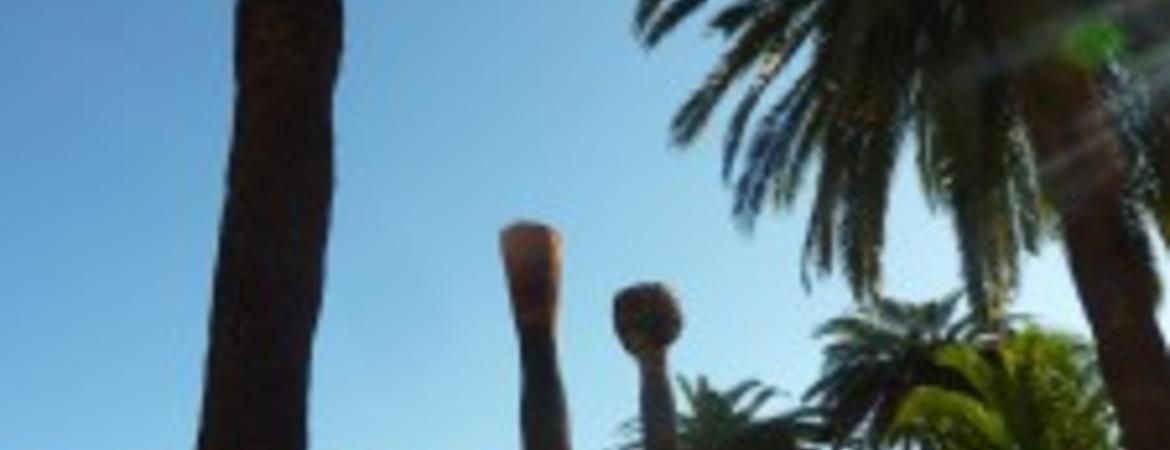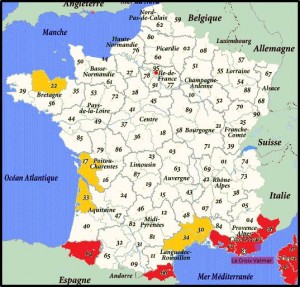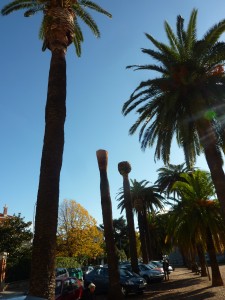
On a recent trip to southern France, I discovered firsthand how destructive red palm weevil (RPW) could be for California if we don’t act fast to eradicate and control this pest.
Unfortunately, for a variety of reasons, the French didn’t have the ability to stop this pest before it exploded into the massive problem they currently face. To comprehend the gravity of their situation, today, the area in France that had the initial outbreak of this pest (La Croix Valmer) has an estimated loss of 80% of their Phoenix palm species; but it doesn’t stop there. This insect has since spread to 5 departments within France with a total estimated loss of 1 million euros per year (~$1.4 million US) with no end in sight. The departments affected by this insect include some famous top-end tourist destinations like St Tropez, Cannes, Monaco, Nice, and Marseille where palm trees are used as symbolic imagery for these areas (think of the Cannes Film Festival-Palm D’or). I believe most of the areas in France with large scale palm production or plantings have been affected by two serious palm pests, the RPW and a day flying moth, Paysandisia (affecting at least 8 departments in France). Hopefully we can learn from the French experience to keep California from realizing the same catastrophic fate.

RPW, or Charançon Rouge du Palmier in French, was first detected in France in La Croix Valmer (near St Tropez) around 2004. This was the first detection of RPW by palm growers, but the enormity of the find was not realized, and it was dismissed as a non-event by the French Plant Protection Services. Consequently, RPW wasn’t officially reported as established in France until 2006, 2 years after the initial find. Then, through a European directive, RPW was deemed a quarantine pest in May 2007 and the only approved treatment for RPW infested palms in France was complete tree removal and disposal. During this time, the French were already overwhelmed by another palm pest; Paysandisia archon, a day flying moth from South America whose larvae tunnel into palm fronds and trunks. The damage caused by RPW and Paysandisia are difficult to tell apart because the larvae of both species cause very similar feeding damage and palm mortality. From my brief experience in France, it appeared that the areas where Paysandisia were initially detected have been taken over by the even more ravenous RPW. We should be looking out for Paysandisia in California as well because it will be extremely destructive should it invade and successfully establish. Additionally, perhaps Paysandisia will make it even easier for subsequent RPW populations to flourish by weakening palms and making them more vulnerable to RPW attack.
In Le Var (Department 83 on map), a group of concerned citizens made up of local growers, nursery owners, researchers (INRA/Phoenix Research Station), and city workers decided to band together to form a non-profit organization to give some weight to their fight against RPW and to obtain support from the French government agencies for managing this pest. This non-profit group, FDGDON (Fédération Départementale des Groupments de Défense contre les Organismes Nuisible) du Var, formed in June of 2007 with 135 members and continues to fight the RPW problem today. However, FDGDON du Var has minimal support from the French Government which has been very slow in responding to the obvious need to develop RPW management programs.
I had the opportunity to spend a day with this dynamic group in Hyères, France to see up close the daily challenges they face with RPW. Hyères is a typical, small picturesque French seaside town about 10 miles east of Toulon. Palms trees of all varieties are quite abundant in the landscape. You really can’t go more than a block without seeing one…or now for that matter, one that has had to be removed leaving an ugly stump in the ground.

All of these concerned individuals have other full time jobs but spend a lot of time dedicated to FDGDON du Var because the RPW invasion has affected their livelihoods and degraded the aesthetic appeal of local neighborhoods, so collectively they want something done about managing this pest. RPW has been problematic in the area where FDGDON du Var has been active for the past ~4 years yet the group is still struggling with the French Government to enact basic protocols and procedures to help them solve the RPW problem. I attended their annual board meeting (17 November 2010 in Hyères) and was amazed at how much red tape FDGDON du Var has to push through when dealing with RPW management which is overseen by federal and local government agencies. It was very obvious from the extremely heated discussions the high levels of frustration with this bureaucracy while RPW slowly eats away at the palms in their backyards and along their road sides. One of the biggest surprises for me was that they are still trying after ~4 years to get their training program, to train individuals to detect and treat for RPW and to remove and dispose of infested palm trees, officially recognized by the French government (~150 individuals have been trained, but the certificates are not valid, thus essentially not recognized as trained for all practical purposes). Without established and effective management protocols in place, many people take it upon themselves to do what they think is best to manage RPW and dispose of dead and infested palms. For example, some people do nothing, which exacerbates the RPW problem for others. Unscrupulous folks claim to know what they are doing and improperly remove palms and dump them into landfills untreated and unchipped, leaving live RPW in exposed palm carcasses ready to emerge and exploit new areas. These fly-by-night palm removers charge less for these budget services which undercuts the responsible landscaping companies who are doing the right thing by chipping and disposing of RPW-infested palms properly.
The French seem to still be struggling to keep up with the RPW invasion in the absence of official recognized training protocols and with a general resistance to review the pesticide list, application rates and methodologies more efficiently. In comparison, other countries in Europe (e.g., Spain and Italy) have had established RPW protocols and preventative treatments in place for awhile (which were also implemented in already advanced stages of pest numbers so consequently they are still struggling with control) while France is still bogged down in prolonged administrative processes; issues that after ~4 years were only recently partially addressed in July 2010 due to the insistance of FDGDON. The French should have learned from the other European countries examples but it doesn’t appear to be the case. It will be tragic if these coastal French towns lose this battle with RPW when something can be done if the right resources are made available. FDGDON du Var is pushing forward with its battle against RPW and Government bureaucracy, albeit slowly.
The lesson from France for California RPW managers is obvious; fast and decisive actions against RPW are needed. California doesn’t have to face the same fate as Hyères and other French coastal towns. It may seem expensive to remove and destroy infested palms or to bring in RPW experts from overseas to help implement major control and research programs; but the alternative of “wait and see” will be exponentially worse and vastly more expensive. Can you imagine California’s urban, and desert oases without palm trees?? How about the date plantations in the Coachella Valley? Date shakes anyone?
